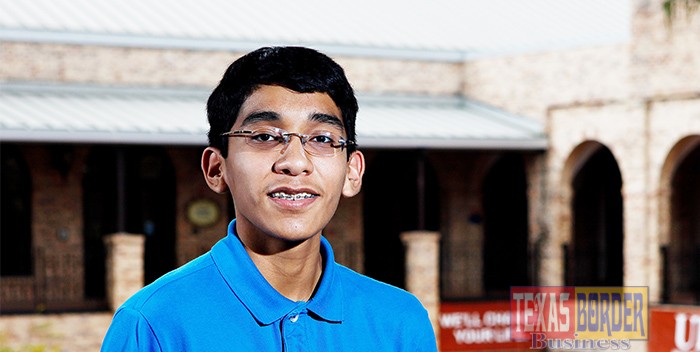
Texas Border Business
BROWNSVILLE, TEXAS – APRIL 7, 2014 – Joel Solis has big plans for the upcoming weeks: earning his learner’s permit to drive and deciding where to attend college.
Brownsville resident Solis, 17, a senior at The University of Texas at Brownsville’s Mathematics and Science Academy, is choosing between The University of Texas at Austin, Harvard University and the Massachusetts Institute of Technology for this fall.
While he is still deciding on his next academic location, he already knows he wants to study chemistry, mathematics and physics.
“At the least I would hope to major in one and minor in the other two,” said Solis.
Mathematics played a role in one of his most recent accomplishments.
He placed third in February in the regional American Mathematics Competition 12 hosted by the university’s Department of Mathematics. Solis, and the rest of the MSA’s AMC12 team, competed against more than 400 students from Cameron and Willacy counties. The MSA team had the second highest cumulative score in the area competition.
“Joel exhibits the qualities of leadership and a stellar work ethic,” said Dr. Wilma Smetter, MSA Principal. “His knowledge of mathematics and science have earned him that distinction among his teammates. When his UTB classes are completed and he returns to the MSA room (in Main), you can see him studying his course materials on the whiteboard and several times throughout the week, he provides extra academic support for his friends who need help. He is always ready to help a classmate.”
Solis grew up in Brownsville and said reading was one of his favorite activities while growing up. He credited “The Usborne Science Encyclopedia” and “Usborne Mysteries and Marvels of Nature” in inspiring him to delve into the sciences.
He attended Saint Joseph Academy before enrolling at MSA. Solis’ had some knowledge about the academy from his cousin Monica Garza of Brownsville, a 2013 MSA graduate and currently a business major at UTB.
“My parents wanted me to come to MSA,” said Solis. “They saw how good of an opportunity it was for my cousin. But I was hesitant to leave Saint Joe’s. I knew at MSA I would have more access to science and mathematics. It turns out I loved it here more than I thought I would. It definitely exceeded my expectations.”
He discovered his knack for mathematic as a sophomore at Saint Joseph. He took the American Mathematics Competition 10 test and scored the highest at the school and in the area competition.
“I knew I could understand some of the math questions,” said Solis. “I didn’t know I would be so inclined toward that field.”
Mathematics is not the only subject he excels in.
Solis said he enjoys chemistry, which he took as a sophomore at Saint Joseph Academy, and physics which he took at UTB for the first time during spring semester.
“It seems to come to me easily,” he said.
Solis is a member of the academy’s first science bowl team. The group placed first in mid-February in the University of Texas – Pan American’s Regional Science Bowl in Edinburg. The group will travel in late April to the U.S. Department of Energy National Science Bowl in Washington, D.C.
“The victory at the regionals definitely motivated us,” said Solis. “We all have a stronger ambition to do well at nationals.”
Solis is also a history tutor in the Linked 2 Success initiative, which was expanded campus-wide in fall 2013, and provides all students with free structured tutoring for freshman courses that have traditionally low pass rates. Highly trained peer tutors lead sessions either directly before or after each class to promote critical thinking and active and strategic learning.
He wants to eventually pursue a master’s degree and a doctoral degree and possibly become a professor and conduct research.
The Mathematics and Science Academy in the College of Science, Mathematics and Technology was created by the 79th Texas Legislature in 2005. Graduating students receive a high school diploma from the Mathematics and Science Academy and have up to 68 semester credit hours, enough to have finished the first two years of college. The first cohort of high school-aged juniors began in fall 2007 and graduated with high school diplomas in spring 2009.













